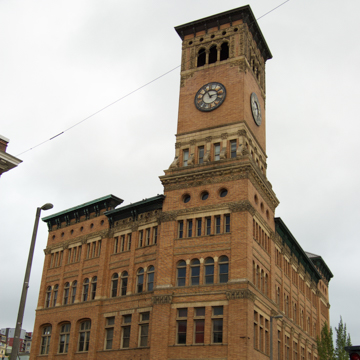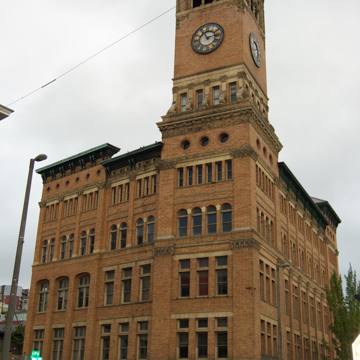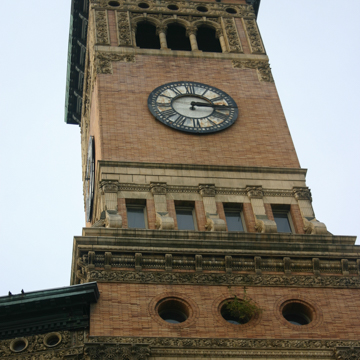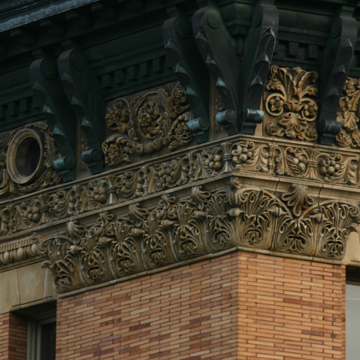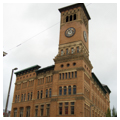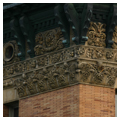You are here
Old City Hall
Anchoring the north end of downtown Tacoma, across Pacific Avenue from the 1888 Italianate building that once served as the Northern Pacific Railway headquarters, Tacoma’s original city hall, completed in 1893 and today known as “Old City Hall,” is a striking structure that reflects the railroad’s role in Tacoma’s birth and the visions of grandeur the city’s founders had for its future. Both buildings stand on a bluff overlooking Commencement Bay, a prominent and conspicuous location, especially to ships coming in from the Pacific Ocean and Puget Sound. Yet Old City Hall’s clock tower rises from the building’s southeast corner and is thus oriented toward downtown Tacoma to the south. In this way, the building suggests its civic importance, and not merely its relationship to the private interests that assisted with the city’s economic rise. Despite the construction of taller buildings in later years, the tower—and the building as a whole—remains an important Tacoma landmark.
The building’s size, massing, and elaborate architectural features helped assert Tacoma’s identity as the dominant city on the Puget Sound in the late nineteenth century. In 1890, the San Francisco–based architectural firm of Hatherton and McIntosh won the competition to design what was initially intended as the home of the Tacoma Chamber of Commerce at Seventh Street and Pacific Avenue. Instead, the building was erected at Ninth Street and Broadway after the Northern Pacific Railway donated the land to the city. The cornerstone credits Edward A. Hatherton as the architect of what is essentially an Italian Renaissance Revival building. Hatherton served as the City of San Francisco’s official architect for about ten years during the 1880s before coming to Tacoma to take advantage of the building boom in the northern city.
City Hall’s trapezoidal footprint follows the shape of the city block on which it stands. Sturdy, load-bearing masonry walls support the main five-story mass of the building and the clock tower. Eight-foot-thick Wilkeson sandstone foundation walls (from Wilkeson, Washington) taper to six-foot-thick walls at street level. Brick walls rise above a foundation faced with reddish-yellow Roman bricks that give the exterior a variegated appearance. Numerous windows pierce the building’s masonry walls: levels two and five feature rectangular windows, though with smaller windows grouped into threes on the uppermost level; the third story has large windows topped by segmental arches; and the fourth story has pairs of arched windows. Brick-clad pilasters separate the windows and help define vertical sections of the building.
On the southeast corner and along the Pacific Avenue facade, two levels of pilasters terminate in terra-cotta Corinthian capitals. The first level ends at the base of the third story; the higher level appears to support an entablature of rich terra-cotta ornamentation, including a frieze of vines and flowers, and a row of round windows. This frieze continues around the entire building, broken by taller brick sections pierced by larger round windows. On the west side of the building, pilasters appear only on the fourth and fifth stories. Pairs of brackets support projecting eaves and a cornice clad in copper runs along the entire parapet roofline. A lower, less prominent tower stands at the northeast corner and terminates just above the roofline of the main mass of the building. Copper-clad hipped roofs top both towers.
The southeast corner of the building transitions to the tower base with a series of scrolled brackets set between narrow rectangular windows. Above, a clock face centered on a broad expanse of brick marks each side of the tower. Each side of the upper portion of the tower is defined by a three-bay terra-cotta arcade topped by a terra-cotta frieze with round windows. Inside this upper part of the tower are the clock chimes and bells, which Hugh and Mildred Wallace gifted to the city in 1904 in memory of their daughter.
The building served as Tacoma’s city hall until 1959, by which time it was so deteriorated after decades of neglect that the city sought other quarters. Beginning in the 1960s with the construction of I-5 (which bypassed downtown) and the Tacoma Mall, located five miles south of downtown, traffic in the central business district declined and many businesses closed. The Old City Hall, like many other buildings in the area, struggled to attract and retain tenants. After the city government moved out, the building stood vacant until the 1970s, when the Barnett Schorr Company renovated it for use as offices, shops, and restaurants. In 1981, the building was revived yet again with its reconfiguration as an office building. In the early 2000s, a Seattle developer purchased the building with plans to convert it into high-end condominiums but the economic recession halted the project before work could begin.
In 2015, the City of Tacoma used funds earmarked for historic preservation and economic development to buy the building, though without clear plans for the structure’s future use. The building’s potential for commercial revitalization is hampered somewhat by its location at the north end of the central business district: it stands one mile north of the area where most of downtown Tacoma’s recent economic revitalization has occurred—around the federal courthouse at Union Station and the University of Washington Tacoma campus. The Old City Hall retains much of its beautiful terra-cotta ornamentation, but given its poor condition and the need for a seismic retrofit among other structural repairs, much work is required to return the building to its former grandeur while meeting the needs of prospective twenty-first-century tenants.
References
“E. A. Hatherton Gone from Home.” San Francisco Call79, no. 111 (March 20, 1896): 14.
Gallaci, Caroline, and Patricia A. Sias, “Old City Hall Historic District,” Pierce County, Washington. National Register of Historic Places Inventory–Nomination Form, 1977. National Park Service, U.S. Department of the Interior, Washington, D.C.
Martin, Kate. “Tacoma Now Owns Old City Hall.” The News Tribune(Tacoma, WA), July 17, 2015.
Morgan, Murray. Puget’s Sound: A Narrative of Early Tacoma and the Southern Sound. Seattle: University of Washington Press, 1979.
Schorr, Barnett P., “Old City Hall,” Pierce County, Washington. National Register of Historic Places Inventory–Nomination Form, 1973. National Park Service, U.S. Department of the Interior, Washington, D.C.
“Old City Hall.” Tacoma-Pierce County Buildings Index. Tacoma Public Library, Tacoma, WA. Accessed August 5, 2015. www.tacomalibrary.org.
Woodbridge, Sally B., and Roger Montgomery. A Guide to Architecture in Washington State: An Environmental Perspective. Seattle: University of Washington Press, 1980.
Writing Credits
If SAH Archipedia has been useful to you, please consider supporting it.
SAH Archipedia tells the story of the United States through its buildings, landscapes, and cities. This freely available resource empowers the public with authoritative knowledge that deepens their understanding and appreciation of the built environment. But the Society of Architectural Historians, which created SAH Archipedia with University of Virginia Press, needs your support to maintain the high-caliber research, writing, photography, cartography, editing, design, and programming that make SAH Archipedia a trusted online resource available to all who value the history of place, heritage tourism, and learning.

